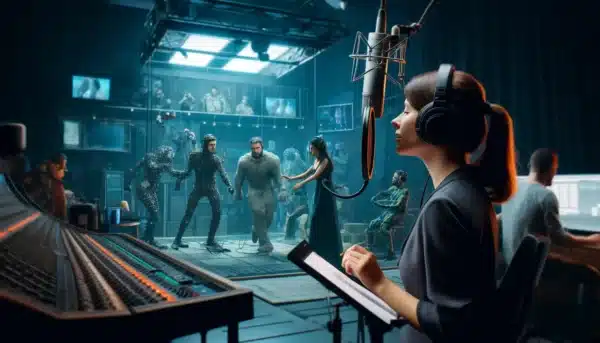Voice acting in video games has become an integral part of the gaming industry, bringing characters to life and immersing players in rich, engaging narratives. As the demand for high-quality voice acting grows, it’s essential for aspiring and established actors to understand the intricacies of this unique craft. This essay will explore the various aspects of voice acting in video games, from the recording process to the different approaches in performance, and provide insights from industry professionals.
A typical voice acting session in the video game industry involves a close collaboration between the actor, director, engineer, and producer. The director guides the actor’s performance, ensuring that it aligns with the game’s narrative and the character’s arc. The engineer is responsible for the technical aspects of the recording, such as setting up the microphone, adjusting levels, and monitoring the audio quality. The producer oversees the entire process, making sure that the sessions run smoothly and efficiently.
When it comes to performance approaches, voice actors employ a wide range of techniques to bring their characters to life. Nolan North, known for his roles as Nathan Drake in the “Uncharted” series and Desmond Miles in the “Assassin’s Creed” franchise, often uses a naturalistic approach. This style involves delivering lines in a way that feels authentic and conversational, as if the character is speaking in real life. North’s performances are characterized by his ability to convey a sense of wit, charm, and vulnerability, making his characters relatable and engaging.
On the other hand, some roles require a more stylized or exaggerated approach. Troy Baker’s performances as Joel in “The Last of Us” and Revolver Ocelot in the “Metal Gear Solid” series showcase his ability to portray complex, emotionally charged characters. Baker’s voice acting is known for its depth, range, and intensity, as he skillfully navigates the emotional landscape of his characters. His performance as Joel, in particular, demonstrates his ability to convey a sense of grit, determination, and paternal instinct, making the character’s journey all the more compelling.
When working with a microphone in a studio setting, voice actors must be mindful of several technical considerations. Maintaining a consistent distance from the microphone is crucial to ensure a balanced and professional-sounding recording. This technique, known as mic technique, involves finding the sweet spot where the actor’s voice sounds clear and full without being too loud or distorted. Additionally, actors must be aware of plosives (the harsh sounds created by the release of built-up air pressure when pronouncing certain consonants) and sibilance (the excessive emphasis on “s” and “sh” sounds). Pop filters and proper mic placement can help mitigate these issues, resulting in a cleaner, more polished performance.
Studio recording for video games often involves solo sessions, where the actor works independently without the presence of other cast members. This approach allows the actor to focus solely on their own performance, diving deep into the character’s psyche and emotions. Solo sessions also provide the opportunity for multiple takes and experimentation, as the actor can explore different interpretations and nuances without the pressure of time constraints or the need to coordinate with other actors.
In contrast, performance capture is a more collaborative and physically demanding process. This technique involves recording an actor’s voice, facial expressions, and body movements simultaneously, using specialized cameras and motion capture suits. Performance capture sessions often take place in a dedicated volume, where actors work together to bring scenes to life. The interaction between actors in performance capture allows for more organic and dynamic performances, as they can respond to each other’s cues and movements in real-time.
A prime example of the power of performance capture can be seen in the performances of Ashly Burch and Hannah Telle in the “Life is Strange” series. Burch and Telle’s portrayal of the complex friendship between Chloe and Max is enhanced by their ability to interact with each other in the volume, creating a sense of intimacy and authenticity that resonates with players. The nuanced facial expressions and body language captured during these sessions add an extra layer of depth and realism to the characters, making their emotional journey all the more impactful.
To excel in the world of video game voice acting, actors must possess a deep understanding of their character’s arc and the overall narrative of the game. This knowledge allows them to make informed choices about their performance, ensuring that their delivery aligns with the character’s development and the story’s themes. Actors should also be willing to take risks and experiment with different approaches, as video games often require a wide range of vocal styles and emotions.
Collaboration and adaptability are also essential skills for voice actors in the gaming industry. Working closely with directors, writers, and other members of the development team is crucial to ensure that the final product meets the creative vision of the project. Voice actors must be open to feedback and willing to make adjustments to their performance as needed. Additionally, as the gaming industry continues to evolve, actors must be prepared to work with new technologies and techniques, such as remote recording and virtual production.
In conclusion, voice acting in video games is a multifaceted and challenging craft that requires a unique set of skills and techniques. From the technical aspects of studio recording to the collaborative nature of performance capture, voice actors must navigate a complex landscape to bring their characters to life. By studying the work of industry professionals, honing their mic technique, and cultivating a deep understanding of their characters and the game’s narrative, aspiring voice actors can develop the tools and expertise needed to succeed in this exciting and ever-evolving field. As the gaming industry continues to grow and push the boundaries of storytelling, the role of voice actors will only become more crucial in creating immersive, emotionally resonant experiences for players around the world.
Be sure to read "SHOCKING: D.C. Douglas Exposes Truth About 101 Voice Actors!"








